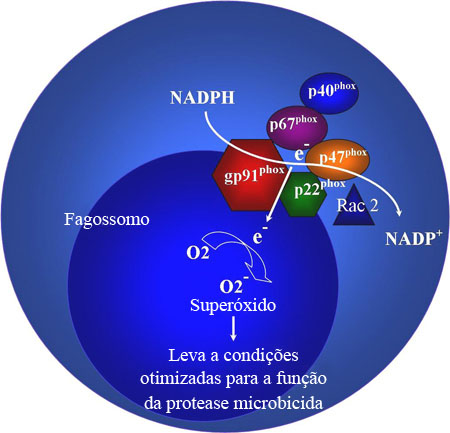Resumo
Definição
História e exame físico
Principais fatores diagnósticos
- presença de fatores de risco
- história de infecções prévias
- dispneia
- dor perianal
- dor no flanco
- lesões vermelhas da pele
- exames torácicos anormais
- calafrios
- febre
- linfadenopatia crônica
- baixo crescimento
- dor nas articulações
- dor facial
- lesões coriorretinianas
- cicatrização desfigurante da pele
Outros fatores diagnósticos
- fadiga
- diarreia
- dor abdominal
- tosse
- anorexia
- artralgias
- náuseas e vômitos
- hematúria
- fluxo urinário anormal
- hepatoesplenomegalia
- história familiar de lúpus discoide
- úlcera oral
- erupção cutânea
Fatores de risco
- história familiar de doença granulomatosa crônica
- idade <5 anos
- sexo masculino
- inativação anormalmente distorcida do cromossomo X nos portadores da forma ligada ao cromossomo X
- polimorfismos da mieloperoxidase e dos FCgammaRIIIb
Investigações diagnósticas
Primeiras investigações a serem solicitadas
- Hemograma completo
- Velocidade de hemossedimentação (VHS)
- proteína C-reativa
- calprotectina fecal
- tomografia computadorizada (TC) do tórax
- TC ou ultrassonografia para infecção ativa
- tomografia por emissão de pósitrons (PET) com fluordesoxiglucose (FDG) F-18 de corpo inteiro
- ressonância nuclear magnética (RNM)
- colonoscopia
- testes de função pulmonar
- teste do nitroazul de tetrazólio (NBT)
- teste da di-hidrorodamina (DHR) 123
Investigações a serem consideradas
- sequenciamento genético para os genes codificando os componentes da nicotinamida adenina dinucleotídeo fosfato-oxidase (NADPH oxidase)
- Western blotting
- análise da citometria de fluxo dos componentes individuais da NADPH oxidase
Algoritmo de tratamento
infecção ativa sem risco de vida: na primeira apresentação
infecção ativa com risco de vida: na primeira apresentação
após o tratamento empírico inicial
após resolução de episódio agudo
Colaboradores
Autores
David Lowe, MA, MB Bchir, PhD, FRCP
Consultant Clinical Immunologist
The Royal Free Hospital
London
UK
Declarações
DL has received personal fees from Gilead for an educational video and from Merck for a roundtable discussion. He has received speaker fees from Biotest, Takeda, and Astra-Zeneca and support to attend a conference from Octapharma. DL also holds research grants from NIHR, MRC, LifeArc, GSK, and Bristol Myers Squibb and has received consultancy fees from GSK paid to his institution.
Agradecimentos
Dr David Lowe would like to gratefully acknowledge Dr Adrian Thrasher, Dr Rebecca A. Marsh, and Dr Jack J. Bleesing, previous contributors to this topic. AT is an author of a number of references cited in this topic. RAM and JJB declare that they have no competing interests. Dr Rebecca A. Marsh and Dr Jack J. Bleesing wish to thank Dan Marmer, Carrie Koenig, and the Cincinnati Children's Hospital Clinical Diagnostic Immunology Lab. They also wish to thank Steven M. Holland, MD, Thomas Fleisher, MD, and Anthony Segal, MD, PhD, for helpful correspondence.
Revisores
Niraj C. Patel, MD, MS
Associate Professor of Pediatrics
Duke University
Durham
NC
Declarações
NCP is on the Speakers Bureau for Amgen.
Andrew Gennery, MD
Reader in Paediatric Immunology & HSCT
Institute of Cellular Medicine
Medical School
Newcastle University
Newcastle-upon-Tyne
UK
Declarações
AG is an author of a reference cited in this topic. AG declares that he has no competing interests.
Créditos aos pareceristas
Os tópicos do BMJ Best Practice são constantemente atualizados, seguindo os desenvolvimentos das evidências e das diretrizes. Os pareceristas aqui listados revisaram o conteúdo pelo menos uma vez durante a história do tópico.
Declarações
As afiliações e declarações dos pareceristas referem--se ao momento da revisão.
Referências
Principais artigos
Thomsen IP, Smith MA, Holland SM, et al. A comprehensive approach to the management of children and adults with chronic granulomatous disease. J Allergy Clin Immunol Pract. 2016 Nov-Dec;4(6):1082-8. Resumo
Bonilla FA, Khan DA, Ballas ZK, et al. Practice parameter for the diagnosis and management of primary immunodeficiency. J Allergy Clin Immunol. 2015 Nov;136(5):1186-205.e1-78.Texto completo Resumo
Artigos de referência
Uma lista completa das fontes referenciadas neste tópico está disponível para os usuários com acesso total ao BMJ Best Practice.

Diagnósticos diferenciais
- deficiência da adesão leucocitária tipo I
- deficiência de glicose-6-fosfato desidrogenase
- deficiência de mieloperoxidase
Mais Diagnósticos diferenciaisDiretrizes
- Chronic granulomatous disorder: a guide for medical professionals
- Practice parameter for the diagnosis and management of primary immunodeficiency
Mais DiretrizesConectar-se ou assinar para acessar todo o BMJ Best Practice
O uso deste conteúdo está sujeito ao nosso aviso legal